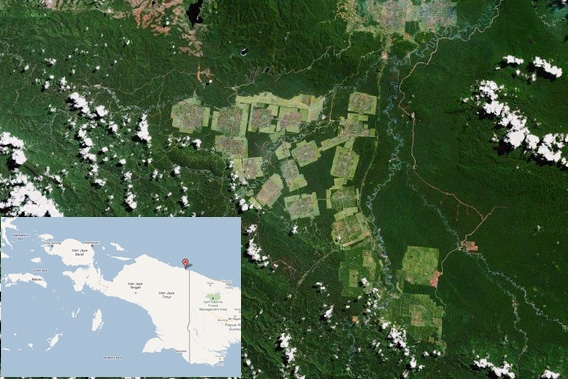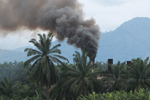
Plantations outside of Jayapura in Papua province. Images from Google Earth/Maps.
Indonesia’s Ministry of Forestry has approved conversion of some 3 million hectares of natural forest in Papua province, on the island of New Guinea, according to new analysis by Greenomics Indonesia, an environmental group.
Data from Greenomics Indonesia indicates 17 companies have been granted concessions to clear natural forest in Papua. Roughly 1 million hectares is earmarked for industrial plantations that will supply the pulp and paper industry.
Greenomics Indonesia alleges that six of the companies, which together hold 1.2 million hectares, have been exempted from the moratorium on concessions in natural forest and peatland areas.
Greenomics Indonesia’s Executive Director Elfian Effendi says the plan could transform the heavily forested province.
“It will be no different from what has happened in Riau Province,” Elfian said, referring to the province in Sumatra that has been largely deforested for palm oil and pulp and paper production.
Elfian urged Indonesian President Susilo Bambang Yudhoyono to immediately clarify the proposed moratorium on forest conversion. The moratorium has been in legal limbo since January 1, 2011.
“We must at all costs avoid a situation where the government itself creates a new and protracted period of uncertainty.”
Related articles
Does chopping down rainforests for pulp and paper help alleviate poverty in Indonesia?

(01/13/2011) Over the past several years, Asia Pulp & Paper has engaged in a marketing campaign to represent its operations in Sumatra as socially and environmentally sustainable. APP and its agents maintain that industrial pulp and paper production — as practiced in Sumatra — does not result in deforestation, is carbon neutral, helps protect wildlife, and alleviates poverty. While a series of analyses and reports have shown most of these assertions to be false, the final claim has largely not been contested. But is conversion of lowland rainforests for pulp and paper really in Indonesia’s best economic interest?
Will Indonesia’s big REDD rainforest deal work?

(12/28/2010) Flying in a plane over the Indonesian half of the island of New Guinea, rainforest stretches like a sea of green, broken only by rugged mountain ranges and winding rivers. The broccoli-like canopy shows little sign of human influence. But as you near Jayapura, the provincial capital of Papua, the tree cover becomes patchier—a sign of logging—and red scars from mining appear before giving way to the monotonous dark green of oil palm plantations and finally grasslands and urban areas. The scene is not unique to Indonesian New Guinea; it has been repeated across the world’s largest archipelago for decades, partly a consequence of agricultural expansion by small farmers, but increasingly a product of extractive industries, especially the logging, plantation, and mining sectors. Papua, in fact, is Indonesia’s last frontier and therefore represents two diverging options for the country’s development path: continued deforestation and degradation of forests under a business-as-usual approach or a shift toward a fundamentally different and unproven model based on greater transparency and careful stewardship of its forest resources.